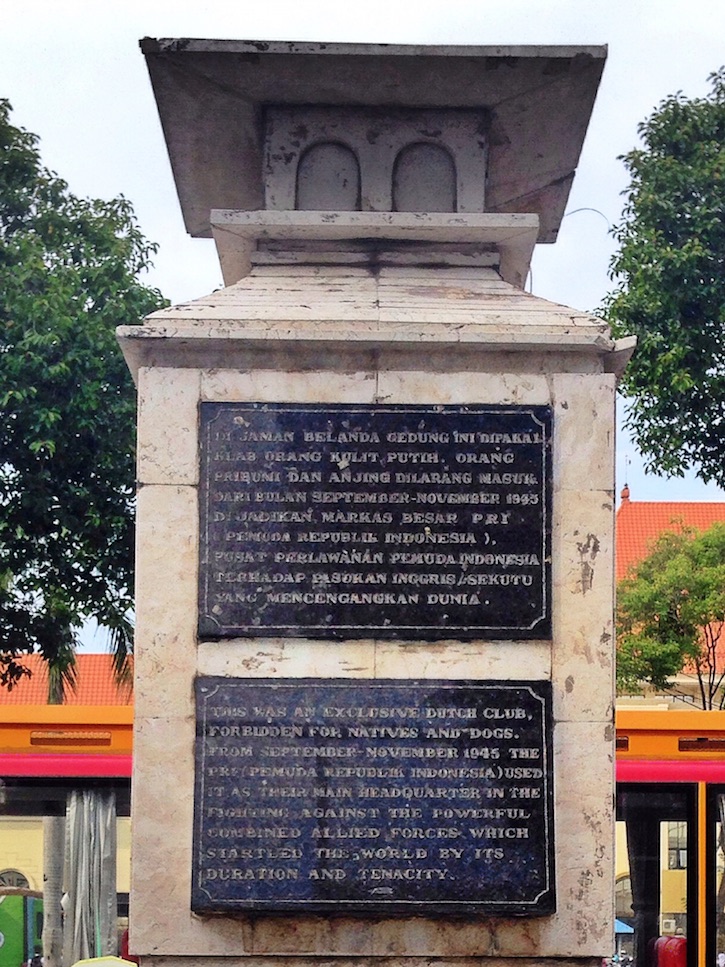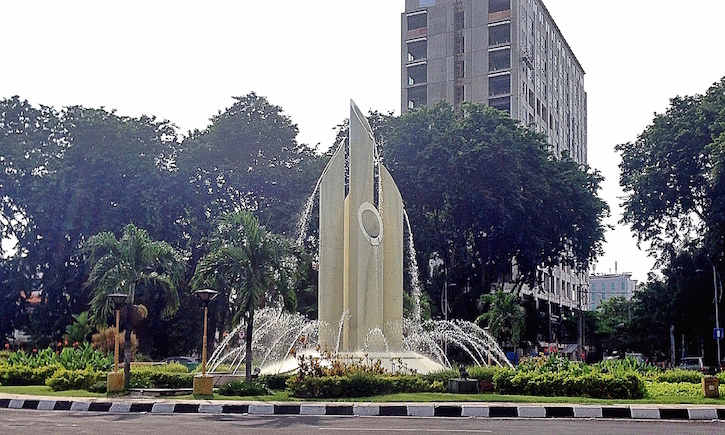Rosalind Hewett
Two key monuments in the city of Surabaya commemorate the actions of the pemuda (young Indonesian freedom fighters) in Indonesia’s 1945–49 revolution against the Dutch. The Monumen Bambu Runcing (Bamboo Spear Monument) celebrates the bamboo spear, the weapon typically associated with the pemuda. The second is a plaque outside the Gedung Balai Pemuda (Youth Hall), the former Simpang Club, which outlines the building’s importance in Indonesian history. According to the English version of the plaque:
‘This was an exclusive Dutch club, forbidden for natives and dogs. From September-November 1945 the PRI (Pemuda Republik Indonesia) used it as their main headquarters in the fighting against the combined Allied forces, which startled the world by its duration and tenacity.’
Both monuments celebrate the pemuda as independence heroes who took action to expel the Dutch and their allies from Indonesia. Both are also problematic in the fact that they represent only one version of history, written and shaped by the winners to portray their actions as contributing to the greater good of the nation.
Excusing mass murder
Like the 1965 communist massacres, in Indonesian historical writing, the 1945-47 killings – if mentioned at all – have generally been portrayed as unfortunate but necessary for the sake of the nation. Autobiographies and popular histories in Indonesia portray pemuda actions against gangs of armed Dutch and Indo (Eurasian) men and former Japanese colonisers as an extreme but necessary response to colonial oppression, and one that was vital to prevent colonial rule from taking hold again after the Japanese surrender. These accounts do not mention that the victims included unarmed women, children and the elderly. Nor do they mention that a significant number of victims were from ethnic groups now considered to be Indonesian. The few mentions of incidental killings that were not part of clashes between armed groups are explained as unfortunate incidents that were perpetrated by an out-of-control rakyat (populace), just like the 1965 killings.
Dutch and British archives tell a different story. These indicate that the pemuda deliberately rounded up and killed or forced other Indonesians to kill unarmed men, women and children, and that a good proportion of victims were from groups that are now considered Indonesian – they formed perhaps a greater percentage than the Dutch and Indo victims. Most of these were Ambonese and Manadonese, but some were also Timorese, Chinese Indonesians, Javanese and Sundanese women married to European men, adopted Indonesian children of Dutch families, and Indonesians who had served as colonial administrators. Autobiographies and personal accounts suggest that pemuda groups targeted European, Indo, Ambonese and Manadonese families in Java based on their appearance, whether they were loyal to the Dutch or not. Further research is needed to show whether perpetrators deliberately intended to eliminate these specific ethnic groups, but the killing of infants and young children signifies that this was so.
Enacting mass murder
During the worst of the violence in 1945, pemuda groups typically entered villages, shouting words like ‘siap, siap!’ (‘get ready!’). The Dutch-Indonesian name for the period, the Bersiap, originates from this term. They spread propaganda via leaflets and loudspeakers and then rounded up local families who they considered loyal to the Dutch on the basis of their ethnicity. In one notable case, in the early hours of the morning on 10 October, a car drove slowly through the streets of Garut in West Java, with a fitted loudspeaker broadcasting the call for the murder of Europeans, Ambonese, Manadonese and Japanese. About an hour later, members of these groups were dragged from their homes and taken to the village square where a mob had gathered. According to eyewitnesses, members of the mob turned on the prisoners and killed them. The pemuda leader then paid the killers with jewels and gold taken from the victims.

Several accounts from Surabaya and Kuningan in West Java reveal that to reach the prisons, male prisoners were forced to run through lines of pemuda armed with bamboo spears and knives. Reports from across Java state that many prisoners disappeared in the middle of the night from their prison cells and were buried in hastily dug mass graves. Women and children were usually sent to internment camps, and surviving male prisoners were sent to separate camps. A number of camps in East Java became notorious killing and torture grounds, most infamously Pacet, located between Malang and Surabaya. Other pemuda gangs in West Java did not round up their victims but rather killed entire families in their homes, usually spearing them with bamboo spears, but also burning victims and burying them alive. Pemuda groups across Java enforced a food boycott against Dutch and Indos. Families were forced to rely on Indonesian servants to smuggle them food, but propaganda spread by the pemuda also targeted former servants and warned them against assisting Dutch and Indo families.
Contemporary accounts of the violence are mostly limited to first-hand statements from witnesses and interrogation reports compiled by Dutch intelligence in 1947 and 1948. Most of these deal with the killing of Dutch citizens. Estimates of the total number of Dutch and Indo deaths from the period, based on these accounts and interviews in the Netherlands, range from 3500 to 30,000. In the memories of many Indos who left Indonesia and had little to do with other groups who were also victims during the same period, the Bersiap became an attempted genocide of Indos. However, Ambonese and Manadonese names are also present in the lists of victims, possibly because individuals from these ethic groups were often members of the Royal Netherlands Indies Army (KNIL) and the colonial civil service and thus linked with the colonial regime.
The Simpang Club
The best-documented killings took place in Surabaya between September and November 1945. European, Indo, Ambonese and Manadonese men and women were rounded up, ostensibly to protect them from violence, and then imprisoned in the Simpang Club. If they were found in possession of items linking them to the Dutch, like flags, pins and so on, they were often beheaded on the spot. If not, they were further interrogated, and sent from the Simpang Club to the Kaliosok and Bubutan prisons. Those sent to Bubutan were never seen again. According to one account, the only trace ever found of these prisoners was a pile of severed legs, shoes still attached. Eyewitnesses from the Simpang Club reported the systematic interrogation, torture and murder of hundreds of people, particularly from 15 to 17 October. Prisoners were regularly forced to clean the thick layer of blood off the floor of the execution room.
The most controversial account of the Simpang Club violence, from an Indonesian woman, names revolutionary hero Sutomo, most famous for his revolutionary radio speeches, as the executioners’ ringleader. In his autobiography, Sutomo claimed that he was present at least once in the Simpang Club during this period. However, he wrote that he was brought there by other pemuda as a ‘prisoner’, and became worried for his own safety after seeing that the pemuda had succumbed to their bloodlust and killed Dutch prisoners. His version contrasts sharply with accounts from other pemuda in East Java which cast him as a key pemuda leader. Publicly questioning the account of one of the major leaders of the independence struggle, however, remains problematic – particularly because Sutomo is a named Pahlawan Nasional (National Hero).
Forgetting mass murder
Finding evidence of this violence within Indonesia is difficult because of the almost complete silence on the topic in official and popular accounts. History books, autobiographies, films and even comics portray the pemuda as the heroes of the revolution who forced more cautious republican leaders like Sukarno and Hatta to take action. Occasional references in autobiographies confirm that Manadonese and Timorese men and women on Java ‘disappeared’ or were killed, but these are fleeting. Further complicating the search for first-hand accounts from Indonesia is the fact that most members of the generation old enough to remember the Bersiap have died. In my interviews with Indos on Java, no one was willing to admit that they witnessed violence first-hand, though they acknowledged that they had heard of others experiencing it.
The main problem is that the reporting of the killings is clouded by ideological considerations. The killing of groups now considered Indonesian did not support the narratives of national unity that successive governments promoted. As a result, after the revolution ended, there was little inclination in Indonesia to investigate the killings. Public commemoration of the pemuda in East Java further restricts what can be said about their actions during the period. If we consider just how much the independence struggle has been romanticised in the popular imagination, it is clear why the truth about the killing of civilians, among them a significant number of Eastern Indonesians, might remain completely silenced.
Without a broader historical narrative for individuals to refer to, disappearances from the period are attributed to the general lawlessness in Java and remembered as accidental, unfortunate deaths. Awareness that something much more widespread was taking place – the deliberate imprisonment and slaughter of groups whose appearance or family connections marked them as supporters of colonialism – is clouded by the passage of time, ideological considerations and a lack of documentary evidence. Pointing out that the beginnings of the revolution in Java and Sumatra involved the mass murder of members of groups now included as Indonesian by other Indonesians means questioning the traditional divide in nationalist history between ‘indigenous’ Indonesian victims and ‘foreign’ colonisers. The true extent of the Bersiap killings may never fully come to light for all these reasons.
Rosalind Hewett (rosalind.hewett@gmail.com) is a PhD candidate in Indonesian History at the Australian National University.
Inside Indonesia 125: Jul-Sep 2016{jcomments on}
